Keeping the livestock safe on the homestead, no matter how large or small the land, can seem like an insurmountable chore. Barnyard and even backyard livestock live under constant threat of attack.
Before you can adequately protect your animals, you must discover what predators are lurking about and likely to attack..and then what you can do to thwart the heartbreaking carnage.
Small and young livestock are easy prey for both wild and domestic predators. I teach our flock how to free range as safely as possible from a young age, and with them new additions to the flocks and herds intermingled with mature animals. They quickly learn that broad open spaces are not a good place to be on the homestead.
I train the livestock to follow the queen of the barnyard by tempting them with small healthy treats, teaching them to run to me instead of away, and when to show up for count and put up each evening.
Livestock both large and small, as well as domestic pets can disappear in the blink of an eye around the homestead. Protecting them from wild predators is a massive responsibility and requires daily diligence. You not only must teach farm avoidance to wild predators, but view your domestic pets as both prey and predator, in order to keep safe the animals that put meat, milk, and eggs on your table.
You have little to worry about from well-trained farm breed dogs, but do not take their normally docile behavior around the barnyard livestock for granted. Dogs are typically the biggest threat to goats. To give your barnyard inhabitants and extra layer of protection, even if you choose not to free range your livestock, get a livestock guardian dog that lives and sleeps with them.
Most Deadly Homestead Predators
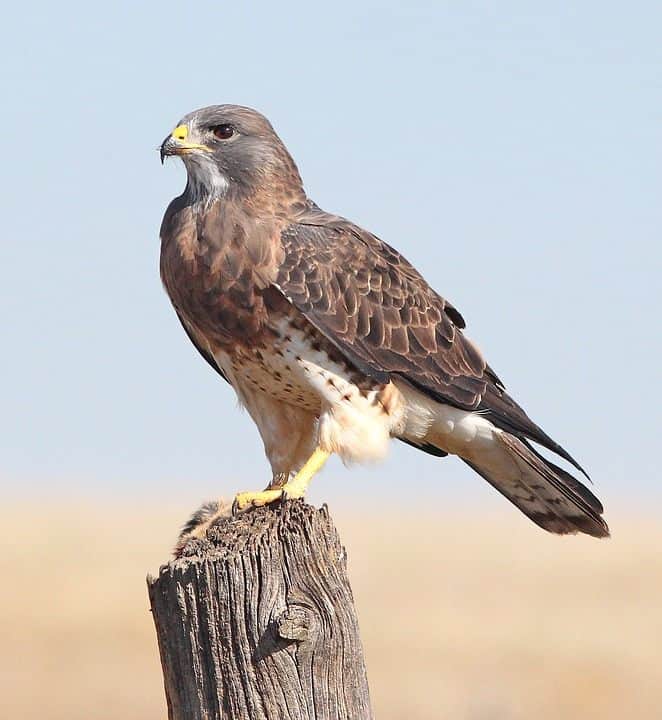
Hawks
These protected predators cannot be trapped or shot and killed. In most states, the law allows farmers and homesteaders the right to kill nuisance predators that threaten their livestock or garden – year round.
Hawks are the number one killer of small poultry like chickens, ducks, guineas, and young turkeys and there just isn’t much you can do about it – except keep your poultry in a coop and a run their entire lives.
A mature hawk can easily lift an about two-thirds of its own body weight – approximately 5 to 8 pounds, depending upon the hawk. While you cannot shoot at hawk, in many states it is still legal to fire you rifle into a hillside, etc. beneath the hawk in order to teach it farm avoidance and scare it away from your homestead. I do this sporadically with different weapons so the hawks do not grow accustomed to the noise.
Hawks generally don’t enter an area where another predator or equal or greater size already exists. Paint a set of large eyes onto the side of your barn, chicken coop, a board turned upward, and anywhere the livestock frequents to trick a hawk into thinking a bigger predator has already staked a claim on the spot.
You can also buy reflective bird tape to attach to posts and structures around the barnyard to scare the hawks away. Shiny duct tape works just as good and is typically cheaper. Hang aluminum pie pans and old CDs around the area to accomplish the same goal. Motion detector owl decoys can help scare away hawks, other owls, and small wild predators as well.

My .22 Henry level action riflle is always kept either in a weatherproof scabbard on my 4-wheeler or in a scabbard attached to my saddle. While you cannot shoot at hawks because of their protected birds of prey status, it is legal in most states to fire into the hillside, etc. In their general vicinity but not direction, to teach them farm avoidance.
The handguns in the photo are my 40C Ruger and a .22 High Point. The inexpensive High Point was a hand-me-down that has seen better years, but is still accurate and functional enough to use as a predator deterrent and a training gun for beginners.
I use a variety of firearms to teach predators farm avoidance, and to protect our livestock. I never go anywhere on our 56-acre homestead without a rifle, and keep a scabbard both on the 4-wheeler and attached to my saddle. We have issues with both wild boar and coyote here – a .22 works well to take down a coyote, but not so much on a large wild boar, especially is you are only an average shot aiming from a moving ATV or horse.
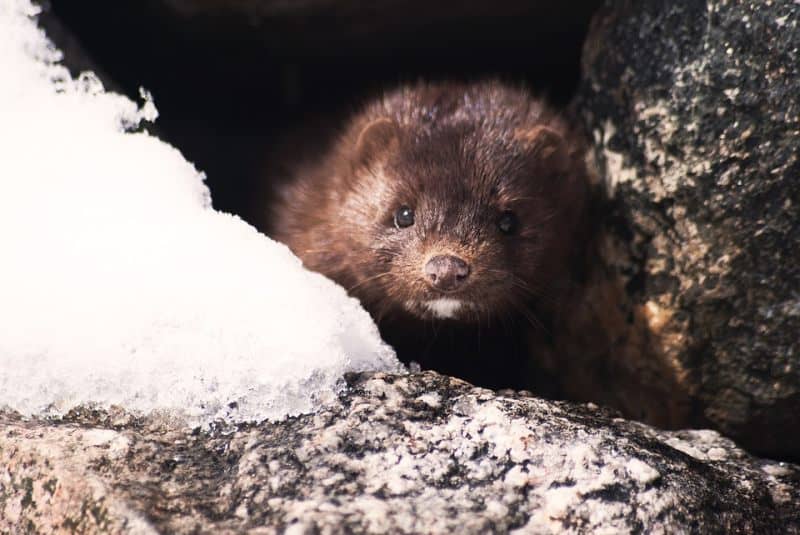
Mink
Now, these nuisance predators you CAN kill. My mother thinks I am cruel, but I enjoy putting down every single mink I possibly can – revenge for killing the first flock of ducks we had on the homestead – before my farm avoidance plan was put into action.
Minks are notoriously hard to find, trap, or shoot. They can make their way through a hole about the size of a quarter – making even a small opening in your pens, hutches, coops, and run a vulnerable point of entry. Minks can fit through standard size chicken wire. Never, ever, under any circumstances, use chicken wire to make an outdoor habitat for small livestock. Eventually, a mink will be able to get through the openings.
Chicken wire is great for keeping small livestock in, but not predators out. Learn to identify the tiny droppings mink leave behind and the somewhat longer than expected and narrow tracks they leave when stalking your livestock.
The image below is a simple snare made out of a thin gauge piece of scrap wire. Once you learn the path a mink is traveling to get to your barnyard, you can create a funnel using natural materials to guide the tiny yet deadly predator, right into the trap.
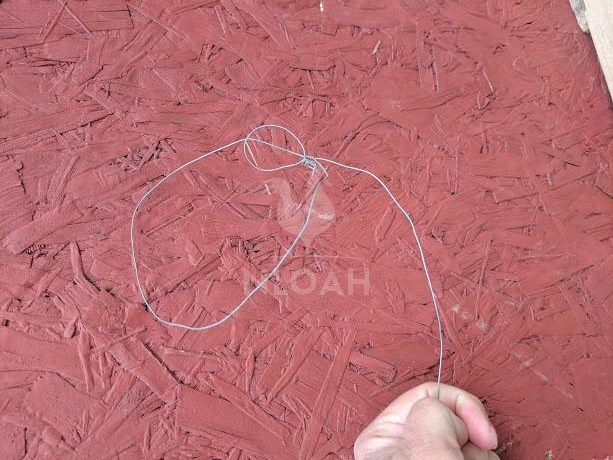
Mink generally do not stray far from a waterway (including ravines and ditches) and avoid open areas, sticking to ground cover as long as possible until they attack.
The photo below is mink scat (droppings). It resembles rat feces. A mink was trying to get into an outdoor poultry brooder but was deterred by my homemade pen that was covered in hardware cloth and then a layer of chicken wire:
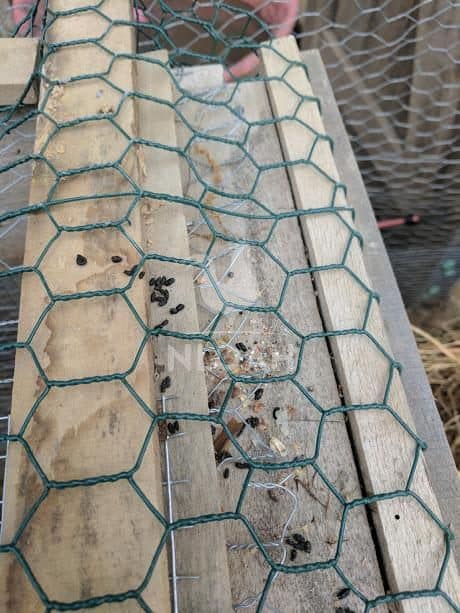
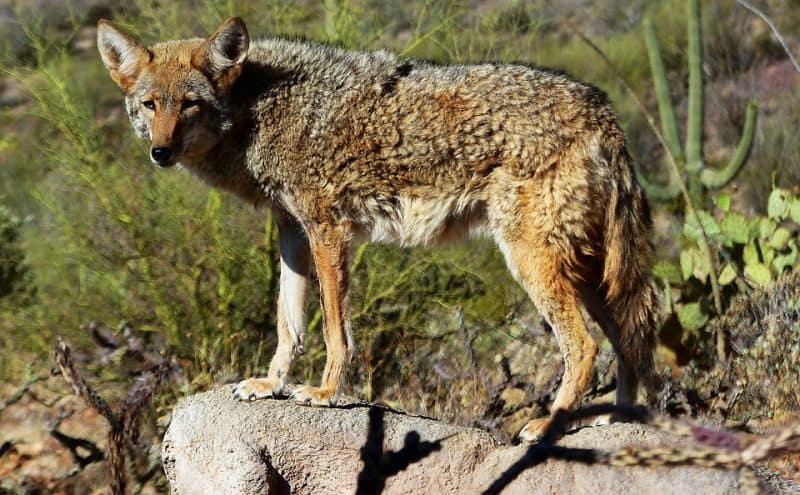
Coyotes
When you hear that familiar howl, you know that it is time to double your barnyard surveillance efforts. Coyotes rarely ever attack large livestock, but can easily kill small and medium livestock. Like a dog, coyotes are capable of killing a goat or sheep very quickly.
In most states it is legal to hunt or trap a nuisance coyote any time of the year. Your state wildlife or natural resources agency will be able to inform you of predator laws and any seasonal limitations.
Miniature donkeys loathe coyotes, and will not only chase them away from your barnyard and pastures but kick them to death when given the chance. Their success in deterring coyotes is one of the reasons mini donkeys are becoming so prevalent on farms and homesteads across the country.
Our miniature donkeys, like the rest of our medium and small livestock, free range around our homestead. Our goats have learned to stay fairly close to the donkeys when they venture into wooded areas to munch on the underbrush.
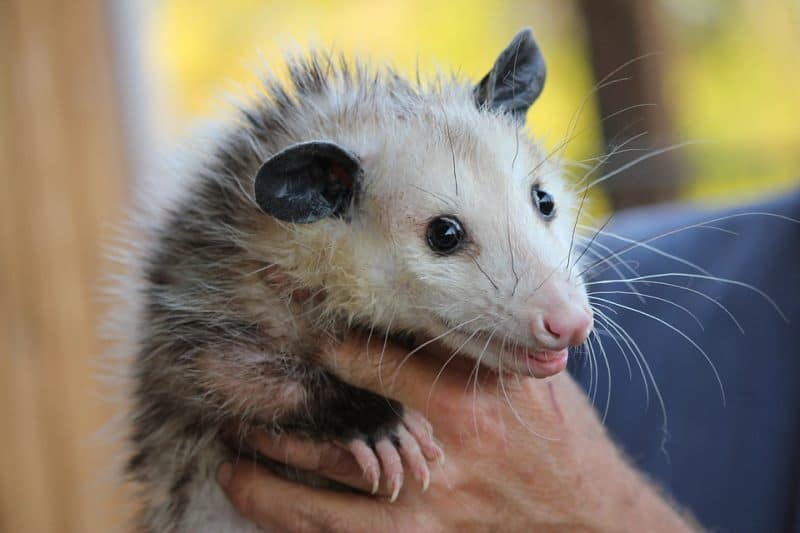
Possums
Many folks do not think possums attack chickens and ducks, but they are wrong. Sure, they typically just steal eggs from nesting boxes when given the opportunity, but they also can and do attack flocks. To thwart their potentially deadly efforts and the continued theft of your eggs, place some motion activated decoys and/or motion detector on your coop, barn, and around the barnyard area.
Possums are not only potentially deadly, they also carry diseases common to all rodents and get into feed tubs. If a possum gets into your feed, you lose money – unless you felt like using your money to feed the wild animals who want to eat your animals. Spilled feed will attract more predators into the barnyard area as well.
If you find an animal that is missing its stomach, the predator was probably a possum that got startled and didn’t get to finish its meal – they tend to eat their prey from the stomach first. Possums have also been known to attack medium livestock like goats and sheep if they are injured if or they’re young. Skunks are also known egg stealers, but can and will attack small livestock when they become really hungry and an opportunity presents itself.
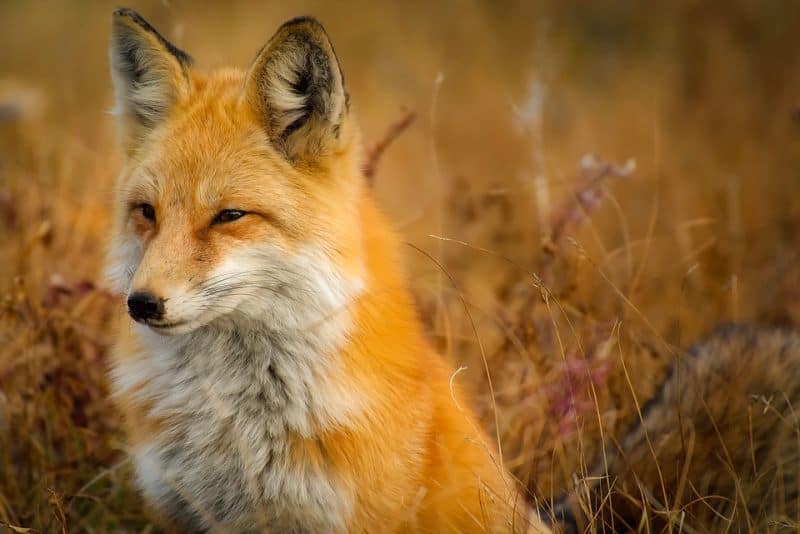
Fox
A fox might not be as large as a coyote, but they are equally deadly. A fox is entirely capable of grabbing a chicken, rooster, or duck and running off to the woods with it to enjoy a meal at your expense. Because the sly predators are both extremely quiet and agile during their attacks, they are massively difficult to catch.
You may be able to trap or shoot a fox thanks to local nuisance predator laws, but you have to be quick enough to spot, aim, and fire at one.To help deter a fox attack, play upon their easy to startle nature and set up motion detector light, animated decoys, and similar moving and shiny objects to not only avert their attention away from the livestock, but to scare them just enough to keep them out of the area.
Guineas are the junk yard dogs of the poultry world. Once mature and free ranging around the homestead they will help protect your livestock, especially the chicken and duck flocks. Their loud calls and willing, perhaps even eagerness to attack a mink or snake, will save the lives of flock members. Because of their desire to attack, expect to loose about half of your guineas each year.
Guineas are a lot smaller than most poultry chicks when they are born, grow really slowly, and seem to die easily. Sometimes the guinea hatchlings (referred to as keets) squish themselves when they pile up at night to sleep. But, having a full flock of guineas around the homestead is worth the time, money, and effort of raising them.
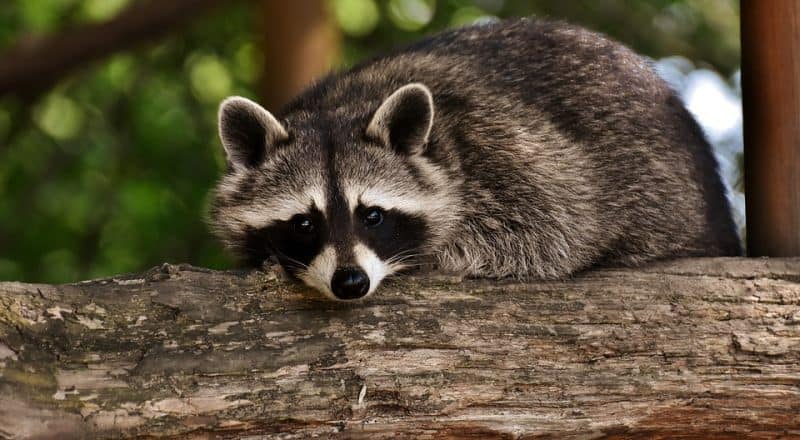
Raccoons
My loathing of mink just barely surpasses the way I feel about raccoons who venture onto our homestead. Like possums, far too many people think coons only steal your eggs. They are very smart little predators and will work all night to take advantage of a potential opening into a chicken coop, feed tub, or rabbit hutch.
Raccoons are fabulous climbers and will even try to climb the walls of your barn to reach the chickens napping in the rafters or to get onto the roof of a coop and slip down inside a vent. Always use at least a 2-step lock on both your poultry and human doors that grant access into your coop and run. A simple 1-step lock will not deter a clever raccoon for very long.
To prevent a raccoon or any other predator from exploiting a worn spot on the coop or where corners meet, I added a layer of hardware cloth around all of the edges. The wood floor of my coop had hardware cloth both under and over it to further prevent tunneling predators from gnawing their way inside.
I also trenched around the coop and run and buried a 1-foot wide strip of hardware cloth around the edges to thwart tunneling predators as well. If the want to burrow into where my flocks are sleeping, it is going to take them days (at least) and they are going to have to work very hard for their meal. The more difficult you make it to get at your animals, the more likely it is that predators will opt for easier prey.
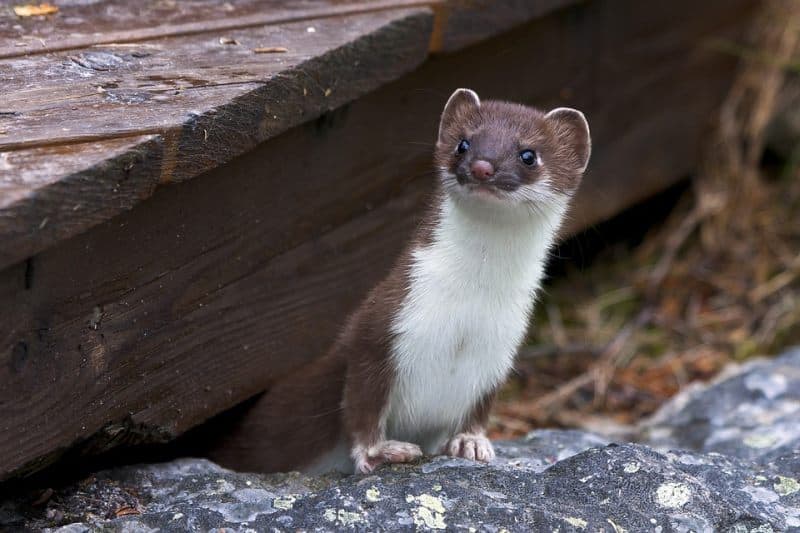
Weasels
These nasty little predators seem to enjoy taunting homesteaders and farmers. They kill far more livestock than they can eat in one setting. If you find chickens or ducks that are either (or both) stacked on top of each other neatly or their necks or head bitten off, a weasel is most likely what you are dealing with around the barnyard.
A weasel can also work itself through tiny spaces like a mink (just not a small) and chew through chicken wire and wood about as well as a raccoon. Use the same tactics to keep weasels away from your barnyard as noted above for mink, coons, and hawks.
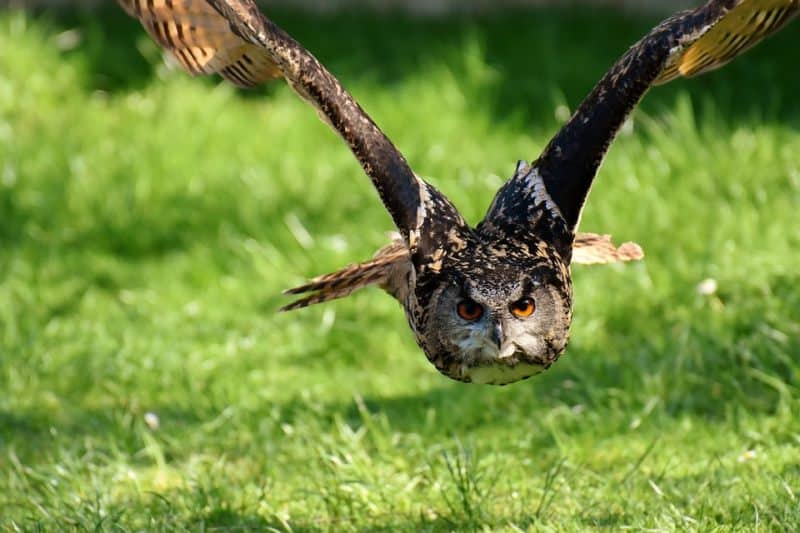
Owls
You do not want one of these majestic birds hanging around your barn. They will eat as many young chickens, ducks, and baby turkeys as they can find. Like hawks, you cannot legally shoot and kill owls. These patient birds are prone to sitting for hours upon hours until prey is in a prime spot for the taking.
If you can train a barn cat to kill only feathered predators and not feathered livestock, keep one in your barn to prevent an owl from taking up residence.
Keeping a cat around the flock is a risk, and takes a well-trained and special cat to be able to differentiated between the birds it is supposed to kill and the ones that will ones that will cause its relocation for attacking. The farm avoidance tactics that help thwart hawks will also deter owls.
Large and Regional Predators
There are a host of large predators that exist in specific regions of the country, that are a threat not only to your livestock, but potentially to the entire homesteading family.
Bobcats
State laws vary, but if the predator is a threat to property, livestock, or human life, it most likely can be shot – but not always. Bobcats are making a reappearance in Appalachia and killing chickens as they re stake a claim on their previous territory, and there is really nothing residents can do about it.
Wild Boar
In our neck of the woods, we tend with wild boar frequently. It is legal to shoot the deadly predators, but deadfall pit traps are the most common way to taking them out. They might be ugly, but wild boar can be tasty, especially when barbequed. The boars are capable of attacking and/or killing small, medium, and large livestock – as well as domestic pets, especially dogs.
Wolves
Like bobcats, wolf populations were once on the decline. The protected status they enjoyed has been lifted in some counties and states in the western United States due to an increase in livestock attacks. Laws pertaining to the trapping, relocation, and shooting of a wolf are very specific, and carry both criminal and civil penalties if violated.
Bears
Due to the encroaching of their habitats, bears are once again on the increase in many regions of the United States. Desperate having enough food, some bears are venturing even into suburban backyards for a meal or water.
Several years ago, before we moved from a small rural town onto our dream homestead, one morning a brown bear was spotted walking on the sidewalks and alleys through town – the night before I lost one of our ducks. We free ranged the ducks in town but put them up into a pen at night. The pen was tall enough the ducks could not get out, but definitely short enough for a bear to reach in and find himself a meal.
Laws pertaining to bears as nuisance predators are also quite specific and vary by state. Making sure feed tubs are secured when not being used, the barnyard is kept free of stray feed and trash, will help prevent a bear attack, at least somewhat.
To deter large predators like bears, keep motion detector lights, solar lights, and a trail camera on and around the barn. If the trail camera detects a large predator like a bear, wolf, elk, or moose that you cannot legally shoot or trap, or are not capable of doing so, call the county or state wildlife agency and request their assistance – there is no charge for such a service.
Wrap-Up
Learn how to identify the droppings of predators in your region to determine exactly what type of predators is lurking near the flock enhance the coop and run adequately to protect against them and best determine how to deter their dinner plans.
Learning how to detect what predators are breaching the barnyard perimeter is substantially important to the survival of your livestock.
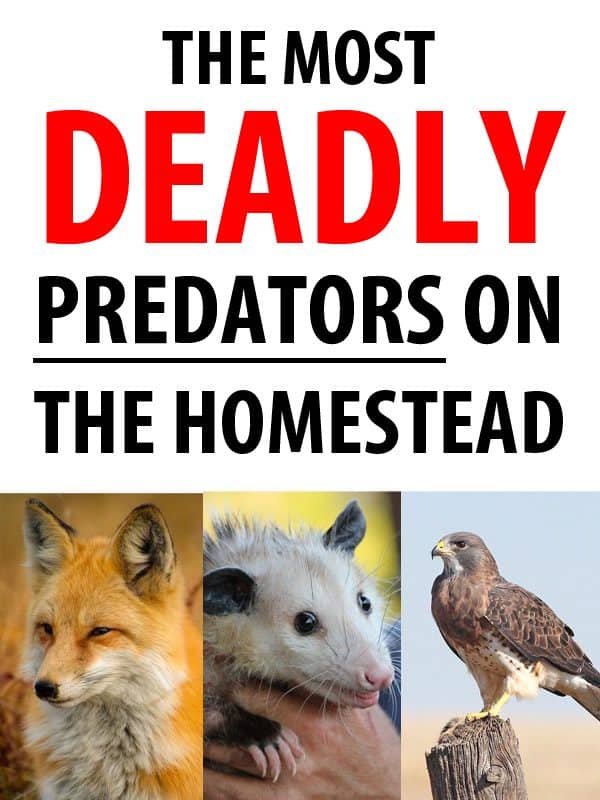

Tara lives on a 56 acres farm in the Appalachian Mountains, where she faces homesteading and farming challenges every single day, raising chickens, goats, horses, and tons of vegetables. She’s an expert in all sorts of homesteading skills such as hide tanning, doll making, tree tapping, and many more.

All good points, but I should point out that it’s not just rural areas. I live in a populated suburb of Richmond, VA and it’s well known that a pair of bears live in the area and sometimes go dumpster diving at local strip malls. Animal control has been after them for a while, but to no avail. I’d hate to be taking out the trash and run into one.
Also, my suburban neighborhood has had reports of coyotes, one of which was described as “sickly looking” which is a red flag for me. Also we have an aggressive neighborhood dog that gets out on his own frequently and will approach other humans, as well as other dogs, very aggressively. The owners have gotten complaints from neighbors, but they ignore them. If I have an encounter with him, I will call Animal Control and not stop bugging them until the dog is impounded.
When I walk my dogs, I have a .38, pepper spray and a pretty substantial knife and I will use any and all if I have to. Unfortunately, the “three S’s” will probably not work in my area. Someone will always be around to hear/see whatever happens. But I know the law and I follow it. I will be happy to explain my actions to the legal system.
Skunks! I think people expect them to not be interested in livestock, I know I did. I lost 35 young chickens, worth about $100, to a skunk this spring. Hard lesson to learn.
Becky,
Wow, that is a horrible loss! I used to not view skunks as a predator, as least not more than as an egg thief, but not anymore. We keep traps set for small predators like skunk all the time now in hopes we can stop a threat before we even know it is lurking about.
you missed feral cats and dogs. Have had problems for years with dumped and feral cats and dogs. When all else fails go with the 3S’s shoot ,shovel and shut up. Jest remember that some DNR’s are releasing with tags some animals you do not want around.
Ben,
I can’t imagine with having to deal with feral cats and dogs too! How awful. I LOVE the 3 S’s…always sound advice!